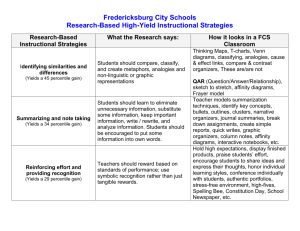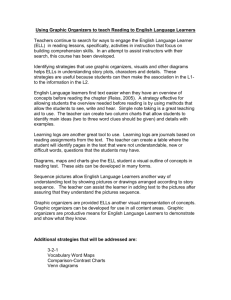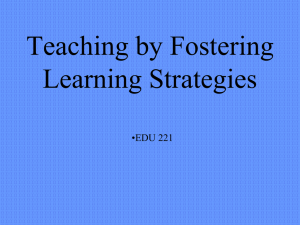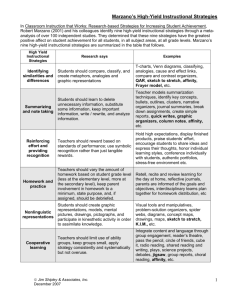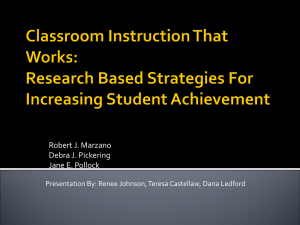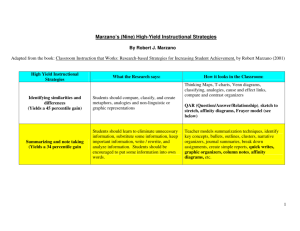Marzano`s (Nine) High-Yield Instructional Strategies
advertisement
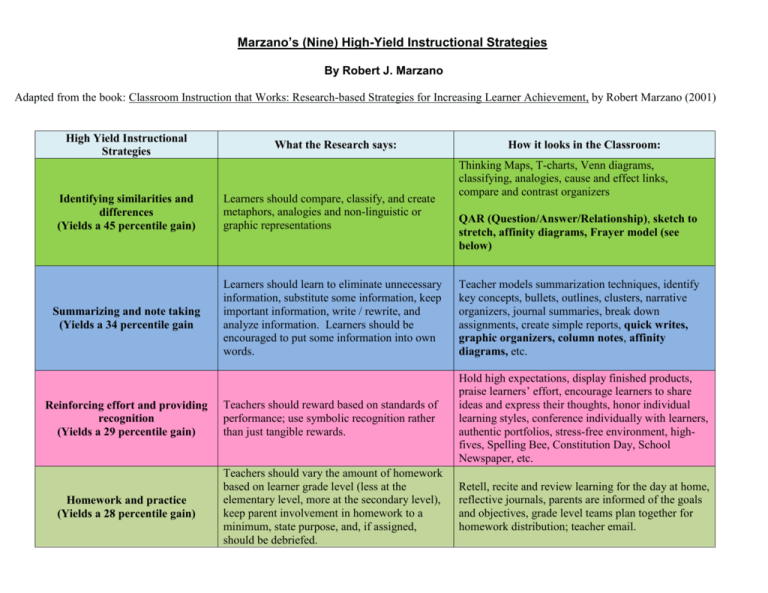
Marzano’s (Nine) High-Yield Instructional Strategies By Robert J. Marzano Adapted from the book: Classroom Instruction that Works: Research-based Strategies for Increasing Learner Achievement, by Robert Marzano (2001) High Yield Instructional Strategies What the Research says: How it looks in the Classroom: Thinking Maps, T-charts, Venn diagrams, classifying, analogies, cause and effect links, compare and contrast organizers Identifying similarities and differences (Yields a 45 percentile gain) Learners should compare, classify, and create metaphors, analogies and non-linguistic or graphic representations Summarizing and note taking (Yields a 34 percentile gain Learners should learn to eliminate unnecessary information, substitute some information, keep important information, write / rewrite, and analyze information. Learners should be encouraged to put some information into own words. Teacher models summarization techniques, identify key concepts, bullets, outlines, clusters, narrative organizers, journal summaries, break down assignments, create simple reports, quick writes, graphic organizers, column notes, affinity diagrams, etc. Reinforcing effort and providing recognition (Yields a 29 percentile gain) Teachers should reward based on standards of performance; use symbolic recognition rather than just tangible rewards. Hold high expectations, display finished products, praise learners’ effort, encourage learners to share ideas and express their thoughts, honor individual learning styles, conference individually with learners, authentic portfolios, stress-free environment, highfives, Spelling Bee, Constitution Day, School Newspaper, etc. Homework and practice (Yields a 28 percentile gain) Teachers should vary the amount of homework based on learner grade level (less at the elementary level, more at the secondary level), keep parent involvement in homework to a minimum, state purpose, and, if assigned, should be debriefed. Retell, recite and review learning for the day at home, reflective journals, parents are informed of the goals and objectives, grade level teams plan together for homework distribution; teacher email. QAR (Question/Answer/Relationship), sketch to stretch, affinity diagrams, Frayer model (see below) Nonlinguistic representations (Yields a 27 percentile gain) Cooperative learning (Yields a 23 percentile gain) Setting objectives and providing feedback (Yields a 23 percentile gain) Generating and testing hypothesis (Yields a 23 percentile gain) Questions, cues, and advance organizers (Yields a 22 percentile gain) Visual tools and manipulatives, problem-solution organizers, spider webs, diagrams, concept maps, drawings, charts, thinking maps, graphic organizers, sketch to stretch, storyboards, act out content, make physical models, etc. Integrate content and language through group engagement, reader’s theatre, pass the pencil, circle Teachers should limit use of ability groups, of friends, shared reading and writing, plays, science keep groups small, apply strategy consistently projects, debates, jigsaw, group reports, choral and systematically but not overuse. Assign roles reading, affinity diagrams, Learners tackle word and responsibilities in groups. problems in groups and explain their answers, etc. Learners should create graphic representations, models, mental pictures, drawings, pictographs, and participate in kinesthetic (hands-on) activities in order to assimilate knowledge. Teachers should create specific but flexible goals, allowing some learner choice. Teacher feedback should be corrective, timely, and specific to a criterion. Articulating and displaying learning goals, KWL, contract learning goals, etc. Teacher can display objectives on the projector and follow-up on the mastery of the objective at the end of the lesson. Learners should generate, explain, test and defend hypotheses using both inductive and deductive strategies through problem solving, history investigation, invention, experimental inquiry, and decision making. Teachers should use cues and questions that focus on what is important (rather than unusual), use ample wait time before accepting responses, eliciting inference and analysis. Advance organizers should focus on what is important and are more useful with information that is not well organized. Thinking processes, constructivist practices, investigate, explore, social construction of knowledge, use of inductive and deductive reasoning, questioning the author of a book, finding other ways to solve same math problem, etc. Graphic organizers, provide guiding questions before each lesson, think aloud, inferencing, predicting, drawing conclusions, skim chapters to identify key vocabulary, concepts and skills, annotating the text, etc.
